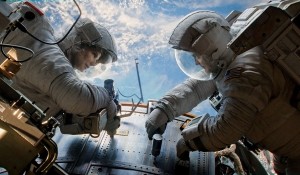Mankind has been obsessed with the cosmos for about as long as there have been people, and it’s no surprise that many a filmmaker’s lens has attempted to capture the vastness and scope of outer space over the years. However, while many films showcase the excitement of going into space (“Apollo 13,” “GATTACA“), less have shown the possible horror of it, where its inhabitants desire not to visit its infiniteness but to make it back to Earth in one piece. Written and directed by Alfonso Cuarón, “Gravity” is such an attempt – a sober and realistic film that shows the aftermath of a disaster in space and the actions, thoughts, and psychology of those searching for the will to survive.
“Gravity” opens with the breathtaking view of Earth from space as Ryan Stone (Sandra Bullock), a Medical Engineer, works painstakingly on a computer board as her tour guide for her first trip in space, Astronaut Matt Kowalski (George Clooney), floats nearby, kept in close quarters by tiny jets of air that push him in whatever direction he wants to go. Stone wants to finish the job and get back inside the craft, while Kowalski is more concerned with breaking the record for space walking. However, “Gravity” has other plans for its characters. Within quick succession and with little warning from Mission Control (Ed Harris), debris from a nearby satellite attacks their shuttle, flinging Kowalski and Stone into space with nothing to grab onto but open air.

“Gravity” is uniquely powerful by the fact that it becomes more than just a disaster movie. The shuttle completely destroyed in seconds, the film’s characters become hopelessly adrift, and work together to attempt to reach a neighboring space station and safety. Floating in space with nothing to grab onto during most times save each other, the film takes on the elemental terror of 2003’s “Open Water,” although more pronounced, as the infinite nature of outer space makes that film’s ocean look small by comparison.
The overall look of outer space, and its unwilling inhabitants is helped greatly by the film’s superb special effects and its cinematography, courtesy of Emmanuel Lubezki, which is at once authentic and captivating. Debris floating in space such as solar panels, pens, and other instruments are rendered with exquisite detail, and oftentimes feel as though they are real enough to touch. The ‘weightless’ quality of these items, as with Stone and Kowalski’s own bodies, seem as though they are floating in water, though the slightest force has the danger of sending them off into infinity. This is best seen during numerous near misses as Kowalksi reaches for an item slipping into the great beyond, or the harrowing opening sequence where Stone is viciously and uncontrollably flung through space as she tries to detach herself from a splintered mechanical arm. I viewed “Gravity” in 3D and cannot imagine experiencing it any other way.
Bullock and Clooney are exceptionally cast as Stone and Kowalski. Clooney seems to be channeling the charismatic personality he is known for a la “Oceans 11,” but here is effective and engaging as a veteran Astronaut confronted with the unthinkable. And Bullock, known more recently for comedies such as “The Heat” and “The Proposal” has never appeared more vulnerable, poignant, and real. Somehow the two play off of each other in a unique way that makes “Gravity” about more than its presented material. Scenes where Stone navigates outer space alone are nerve-wracking and intense, all the more impressive as much of the film’s acting takes place from behind a space helmet. And, while the scenario will not even be hinted at here, one of the most powerful scenes of the movie, a heart-to-heart between Kowalski and Stone, showcases some of the most empathetic and emotive acting seen from Clooney in quite some time.
“Gravity” is, simply put, the reason people go to the movies in the first place. It’s exhilarating, exotic, terrifying, harrowing, and beautiful. Its score is haunting, its acting minimalistic and perfect, and its special effects and cinematography painstakingly gorgeous. Solid throughout, the film’s final ten minutes renders an experience so exquisite you will simply watch with awe. Yet, amidst its spectacular effects and camera shots, “Gravity” also makes poignant observations about life, death, and the will to survive, making it about so much more that can only be gleaned through experiencing it.
Some movies are entertaining, while others are poignant or thought-provoking. However, there are some movies that are transcendent, whose scope, aim, and delivery change the way we think about movies. “Gravity” is an example of the latter; an unforgettable film and certainly one of the year’s best.
– by Mark Ziobro